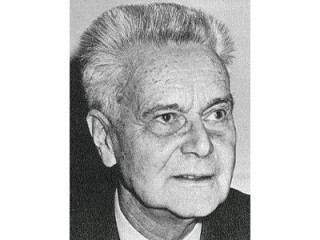
Jan Tinbergen biography
Date of birth : 1903-04-12
Date of death : 1994-06-09
Birthplace : Hague, Netherlands
Nationality : Dutch
Category : Science and Technology
Last modified : 2011-07-18
Credited as : Economist, ,
Jan Tinbergen was born in The Hague on April 12, 1903. He was educated at the University of Leiden, where he earned a doctoral degree in physics. In 1929 he joined the staff of the Central Bureau of Statistics, the economic planning unit of the Dutch government, where he remained until 1945, except for 1936-1938, when he served as a business-cycle research expert for the League of Nations. Beginning in 1933, he accepted a position as professor of development planning at the Netherlands School of Economics, Rotterdam, an institution he served for his entire academic career.
He became director of the Central Planning Bureau of the Dutch government, serving from 1945 to 1955. After that time, he became an advisor to various governments and international organizations, showing particular concern for the problems of underdeveloped countries.
Econometrics, where Tinbergen made his greatest contributions, consists of the application of statistical data and techniques to mathematical formulations of economic theory. It serves to test the hypotheses of economic theory and to estimate the implied interrelationships.
Tinbergen's early work reflects rather clearly the influence of his training in the physical sciences. As early as the 1930s he was publishing papers dealing with the construction of aggregative models of the economy in the form of systems of simultaneous dynamic equations. These were followed by studies of the measurement of the parameters of such models using statistical data. His first complete model was of the economy of the Netherlands. This model was followed by a similar study of the economy of the United States done for the League of Nations. Having constructed the model and statistically estimated the appropriate coefficients, he analyzed its cyclical properties through the solution to the corresponding system of difference equations. His work has served as the principal stimulus for the extensive model-building that has taken place throughout the world in recent years.
Following World War II, Tinbergen's work served as the basis for the use of model projections in the economic planning of the Dutch government. This occurred while he was director of the Central Planning Bureau. The Dutch government has led the world in the systematic use of econometric models in its planning, budgeting, and policy formulation. Many new contributions to the field of econometrics grew out of this activity, and many of the world's leading econometricians cut their professional teeth on the construction and maintenance of the Dutch models.
Among the more prominent of Tinbergen's contributions to econometrics are the introductions of the concepts of "targets" and "instruments." The "targets" are defined in terms of the policy maker's goals. For example, a given level of aggregate output might be a target. With the help of the model, this in turn would show what values of the "instruments" would lead to the achievement of that goal.
The process introduced by Tinbergen is virtually the inverse of the usual procedure in forecasting in which, for given values of the independent variables, the corresponding values of dependent variables are computed. He later extended these same concepts to secular growth models for underdeveloped countries. It might be noted that all of the major econometric models of the United States are in the tradition that began with Tinbergen's work.
Tinbergen wrote extensively on such important topics as the mathematical analysis of the business cycle, the theory of income distribution, the theory of economic growth, the measurement of elasticities of substitution, and the theory of economic development.
Tinbergen served as chairman of the United Nations Committee for Development Planning from 1965 to 1972, as he helped set up more than 20 economic institutes in many parts of the world, including Turkey, India and Chile. In 1969 he shared the Nobel Prize in economic science with Ragnar Frisch of Norway. They received the honor for their work in the development of mathematical models used in econometrics. Tinbergen retired from the Netherlands School of Economics in 1973, having served there for 40 years.
After that, he infrequently published new works on economic theory, including Income Distribution (1975), Warfare and Welfare (with others, 1987), and World Security and Equity (1990). During the 1980s, he urged the world's strong nations to do more for developing countries, saying in an interview, "Individual countries, with their limited resources, cannot stimulate the economy, but together they may succeed." He encouraged a stronger relationship between Europe and Japan, and criticized the U.S. for "standing pat, " rather than increasing aid to countries. In 1992, he received the Four Freedoms Award.
During his lifetime, Tinbergen received 20 honorary degrees from institutions worldwide. He died in The Netherlands on June 9, 1994. The Tinbergen Institute has been established in Rotterdam in his honor.
Author of books:
Statistical Testing of Business Cycles (1938)
Business Cycles in the USA, 1919-32 (1939)
Econometrics (1942)
Business Cycles in the UK, 1870-1914 (1951)
On the Theory of Economic Policy (1952)
Centralization and Decentralization in Economic Policy (1954)
Economic Policy: Principles and Design (1956)
Shaping the World Economy (1962)
Income Distribution (1975)
















